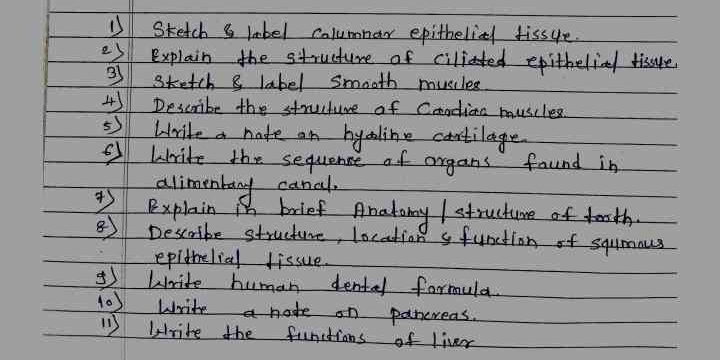1. Sketch & label columnar epithelial tissue. 2. Explain the structure of ciliated epithelial tissue. 3. Sketch & label smooth muscles. 4. Describe the structure of cardiac muscles... 1. Sketch & label columnar epithelial tissue. 2. Explain the structure of ciliated epithelial tissue. 3. Sketch & label smooth muscles. 4. Describe the structure of cardiac muscles. 5. Write a note on hyaline cartilage. 6. Write the sequence of organs found in the alimentary canal. 7. Explain a brief anatomy/structure of teeth. 8. Describe structure, location & function of squamous epithelial tissue. 9. Write human dental formula. 10. Write a note on pancreas. 11. Write the functions of liver.

Understand the Problem
The question contains a series of prompts related to biological concepts, primarily focusing on anatomy and histology. It asks for sketches, explanations, and descriptions regarding various tissues and organs in the human body.
Answer
Key topics: epithelial tissues, muscle types, alimentary canal, teeth, organs.
- Columnar epithelial tissue: tall, column-shaped cells. 2. Ciliated epithelium: tall cells with cilia for moving particles. 3. Smooth muscles: non-striated, spindle-shaped cells. 4. Cardiac muscles: striated with intercalated discs. 5. Hyaline cartilage: firm, flexible tissue with chondrocytes in lacunae. 6. Alimentary canal: mouth, esophagus, stomach, small intestine, large intestine, anus. 7. Teeth: enamel, dentin, pulp. 8. Squamous epithelium: flat cells for protection. 9. Dental formula: 2-1-2-3/2-1-2-3. 10. Pancreas: exocrine and endocrine functions. 11. Liver: detoxification, metabolism, bile production.
Answer for screen readers
- Columnar epithelial tissue: tall, column-shaped cells. 2. Ciliated epithelium: tall cells with cilia for moving particles. 3. Smooth muscles: non-striated, spindle-shaped cells. 4. Cardiac muscles: striated with intercalated discs. 5. Hyaline cartilage: firm, flexible tissue with chondrocytes in lacunae. 6. Alimentary canal: mouth, esophagus, stomach, small intestine, large intestine, anus. 7. Teeth: enamel, dentin, pulp. 8. Squamous epithelium: flat cells for protection. 9. Dental formula: 2-1-2-3/2-1-2-3. 10. Pancreas: exocrine and endocrine functions. 11. Liver: detoxification, metabolism, bile production.
More Information
Epithelial tissues serve as protective barriers. Muscle types vary in structure and function. The alimentary canal outlines the digestive path. The pancreas and liver play crucial roles in digestion and detoxification.
Tips
Confusing the functions of different tissue types is common; focus on their roles and locations.
Sources
- Epithelial Tissue | Anatomy and Physiology I - courses.lumenlearning.com
- Types of tissue: Structure and function - Kenhub - kenhub.com
- Bronchi, Bronchial Tree, & Lungs - SEER Training Modules - training.seer.cancer.gov
AI-generated content may contain errors. Please verify critical information